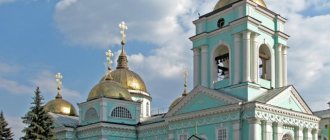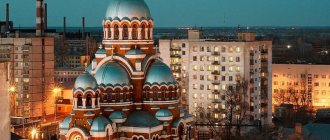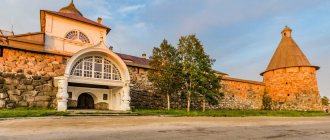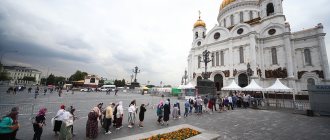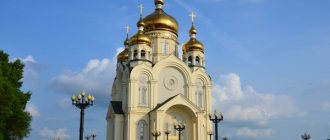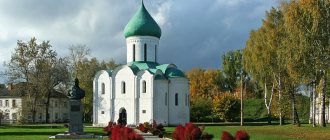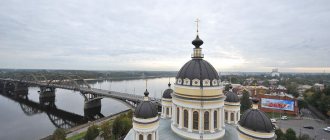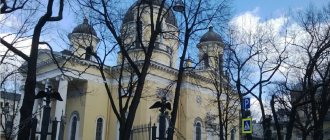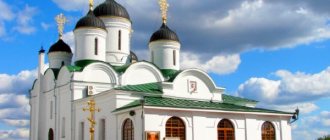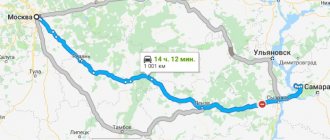About the Preobrazhensky Kremlin and the celibacy of the Old Believers (Preobrazhensky Val, 17)
The entrance group of the men's courtyard of the Preobrazhensky “Kremlin”, also known as the Old Believer monastery, view from the outside. Photo by Yu. Zvezdkin
The entrance group of the men's courtyard of the Preobrazhensky “Kremlin”, also known as the Old Believer monastery, view from the inside. Photo by Yu. Zvezdkin
Old Believer Monastery on Preobrazhensky Val, bell tower.
Photo by Yu. Zvezkin Based on materials from our live excursion “The Kremlin, which you didn’t know about, or Old Believers on Preobrazhenka with a visit to the ancient cemetery,” which you can sign up for here. Tour guide Irina Strelnikova says:
The history of the Preobrazhensky “Kremlin” is connected with the conversion of one remarkable person to the old faith - Ilya Alekseevich Kovylin (the same one who bought the Kremlin Lion Gate, which we talked about last time). The owner of a brick factory in the village of Preobrazhenskoye, where Old Believers have settled for some time. Convinced by their teaching, Kovylin, at a quite conscious age, converted to the old faith - he was re-baptized in 1768, at the age of 37. And just three years later, having shown miracles of ingenuity and talent for negotiation, he had already founded an Old Believer cemetery in Preobrazhenskoye and with it the first Old Believer chapel in the many years of persecution of schismatics. We remember that since the time of Nikon’s reform, since 1656, the official Orthodox Church considered those who cross themselves with two fingers to be heretics and not only did not allow them to build anything, but simply cruelly persecuted them. So Kovylin, one might say, managed to accomplish the impossible.
St. Nicholas Chapel at the Preobrazhenskoye Cemetery, also called the Chapel “About Nine Crosses”. Photo by Yu. Zvezdkin
Here, in fact, a short excursion into the Old Belief is needed. The fact is that there are a great many types and subtypes of the old faith, and the Old Believers of different communities are so different that, except for double-fingered, walking in a procession with the cross, short spelling of the name of God - Jesus and bowing to the ground, there are probably no common features. Well, just like there is little in common between Anglicans, Lutherans and Puritans (although they are all Protestants). Today we are talking about priestless Old Believers. Which, in turn, were also completely heterogeneous, and already at the end of the 17th century they were divided into three communities: the large Fedoseevskaya (how the Fedoseevites appeared and who Feodosius is can be read here) and the Pomeranian and still small Fillipovskaya. The first two are associated with the Preobrazhensky “Kremlin” and the Preobrazhensky cemetery. Also, by the way, they are by no means in agreement with each other in everything, but still rather similar than different, and closely related to each other. Those who are interested in what the difference is can find out here (1); we won’t bore the rest with details. Unlike the less radical Old Believer communities, the Bespopovites do not recognize baptism in the “Nikonian” official Orthodox Church of the Moscow Patriarchate at all (2). So the converts are rebaptized. That is why they are priestless - they simply have nowhere to get priests from. If any priest went over to them, at a new baptism his ordination to the priesthood was canceled. At the same time, they themselves could not ordain anyone - for this they need a bishop. But somehow there were no schismatic bishops (this was a dangerous matter, it could have led to a fire)... Foreign bishops (including Greek, and even from Athos!), who had long ago switched to triplicity, Fedoseevites and Pomeranians are for the Orthodox in principle doesn’t count Russian “Nikonians” even more so... Less radical Old Believers, who did not require rebaptism, could afford to accept fugitive priests from Nikonians - this is how the priesthood was formed, which in turn, in turn, also split into two directions over time (3). And the Fedoseevites and the Pomeranians - alas... And there are no priests, which means there are no sacraments (with the exception of two that are allowed to the laity according to need: baptism and confession). Including there is no marriage, since there is no one to marry. For some time, the Fedoseevites and the Pomeranians amicably adhered to the so-called celibate agreement.
The Bespopovites lived like this until the 80s of the 18th century. That is, they haven’t given birth to children for 100 years. For some time they were not too concerned about this - Nikon’s reform was perceived by them as a clear sign of the Apocalypse. The feeling of the approaching end of the world was so real for the Old Believers that sometimes it even led to oddities. We, however, have already talked about this in the article “The Dwarf of Morozov the Grandson.” In general, if the end of the world is about to happen, what kind of children are there... Well, the communities of Fedoseevites and Pomeranians were reproduced solely through active preaching among the Orthodox, a considerable number of whom the Old Believers managed to convert to their own faith. The official Kabalerov wrote in a report to St. Petersburg in 1851: “<The Old Believers> cunningly know how to not only notice people who are in a difficult state of economic affairs, but also draw into such a situation, especially those prone to a split, and then give them a way to get out of this provisions, and even provide them for the future, donating significant money for this purpose”... Simply put, by converting to the old faith, a person could count on material assistance from the community, or on an interest-free loan to open or develop his own business. Which many people with an entrepreneurial spirit willingly took advantage of (and in many ways this explains such a high concentration of Old Believers among Russian entrepreneurs of the 19th century). You may ask: where did the community get that kind of money? From donations and bequests (who else should I make a bequest if there are no children?). The community initially included several wealthy merchants, and then capital was attracted to the community
The gravestone Chapel of the Exaltation of the Cross (made entirely of cast iron) and the tombstone of the merchant Ilya Alekseevich Kovylin. Photo by Yu. Zvezdkin
more and more talented entrepreneurs only increased (4). By the middle of the 19th century, the total capital of the Fedoseyevsk community exceeded 6 million rubles. In general, social economists are closely studying the phenomenon of increased business success of Protestants in Europe and Old Believers in Russia. There is a certain similarity in the economic sense between Calvinists (also a kind of priestless people) and our Old Believers. Both are successful in business largely due to their special ethics. They have a special attitude towards work: idleness is considered a sin, and any work (be it a goldsmith, a gravedigger, or a doctor) is equally honorable. Wastefulness is also a sin. The industrialist lives little richer than his workers, because he cannot afford sinful luxury on the eve of the Last Judgment. This means that he doesn’t waste what he earns, he puts everything into action. The Old Believers do not have this eternal Russian attitude towards business (5) as money-grubbing, something not quite worthy. For them, earning money and acquiring capital is not a shame. This is not money-grubbing, but a godly deed, because the entire community lives on what you earn and is saved from the sinful world that has given itself over to the Antichrist.
Ilya Alekseevich Kovylin
This is how Ilya Alekseevich Kovylin earned money not for personal enrichment, but for his Preobrazhenskaya community of Fedoseevites. And as a result - the creation of a real center of priestlessness - the Preobrazhensky cemetery. It all started with the plague of 1771. Kovylin used it as a reason to get relief from the authorities from the eternal persecution of the community. Together with his community members, he undertook to treat those sick with the plague, for which a quarantine was arranged. There the patient was isolated and treated to the best of his ability (of course, the plague cannot be cured. But you can strengthen the patient’s immunity, maintain his strength with proper care, and perhaps the body will cope on its own). But the first thing, of course, was to introduce them to their faith, that is, to baptize. It is interesting that the Old Believers do not recognize “pouring” baptism - only three times immersion in water with the top of the head. For this purpose, the Khapilovsky pond was used in Preobrazhenskoye. And this, by the way, happened in late autumn and early winter. The water in the pond – you can imagine what it’s like. So there were many cases where patients recovered after this ice bath. Which, however, does not contradict medical science - after all, shock kills some, and stimulates the immune system for others... Well, if the patient did die, the Old Believers held a funeral service and buried him (no one else bothered with such things - there were too many deaths for this, there was an epidemic claimed about 100 thousand lives, that is, half of the then population of Moscow). For this purpose, they were allowed to build the Preobrazhenskoye cemetery and a chapel with it. The Fedoseevites were not afraid of getting infected - what could possibly frighten people in anticipation of the imminent end of the world?
View of the Preobrazhensky Kremlin from Khapilovsky Pond (now filled in). 1886
Here, of course, we must pay tribute to the philanthropy of the then government. Between the options “let them die and lie in the ground uninveterate, as long as they do not convert to the forbidden old faith” and “let them rebaptize, maybe they will survive, or at least receive a Christian burial,” Count Grigory Orlov chose the second (about how Grigory Grigorievich was sent from St. Petersburg to fight the Moscow plague and how he cleverly ordered it, we tell you on our excursion “Around Verkhniye Sadovniki”). Be that as it may, Kovylin’s calculation was a success. A good thing for the city - the plague quarantine - became its ticket to the right people. Ilya Alekseevich did not skimp on either lavish dinner parties or gifts to influential people. And in the end he managed to get an appointment with Mother Catherine herself. After all, he planned to build a whole complex at the Preobrazhenskoye cemetery - an almshouse for the Old Believers-Fedoseevites: a men's and women's monastery for the poor or simply wishing to live a righteous life, strictly speaking not a monastery, but an institution with a strict monastic charter... With two large churches - on the women's and men's yard. Well, that is, the same Preobrazhensky “Kremlin”. You still had to manage to get permission for this. And... the empress didn’t exactly allow it... She, let’s say, didn’t forbid it. That is, she simply remained silent in response to the question: is it possible? And that was enough. Kovylin built it all at his own expense. Well, I also bought the Lion Gate...
Kovylin supervises the construction of the Preobrazhensky “Kremlin”. 19th century drawing
The Transfiguration Monastery began to be called the “Kremlin” for the inaccessibility of its walls. It was built by the architect Fyodor Sokolov (who, by the way, designed the arsenal building in the Moscow Kremlin). Which was clearly influenced by Vasily Bazhenov with his fabulous “pseudo-Gothic” pavilions of Tsaritsyn...
The almshouse of the Old Believers in Preobrazhenskoye can also be spoken of as a monastery. Although the inhabitants did not take tonsure. But they didn’t need tonsure; the Fedoseevites already lived celibately. This is how the tsar’s official, sent to investigate, describes the order in their monastery: “The food supplies bought at the market were fumigated with incense, they sewed all the necessary things themselves, they cut poppies on their heads, they wore ladders on their hands (leather devices for counting prayers, originally used in Rus', but later replaced by the Orthodox with rosary beads, and by the Old Believers, naturally, left in their original form - Note by SDG). Men found drunk were bowed down, and women were put on a hair shirt and tied with an iron chain.”
Ladder, or ladder
Kovylin's activities greatly stimulated the growth of the community. By the end of his life, the parishioners of the Preobrazhenskoye cemetery were already about 10 thousand... Which, however, was greatly facilitated by permission for marriage and childbearing, which was eventually received by the Bespopovsky community of Pomeranians who lived in Preobrazhenskoye, next door to the Fedoseevites, from their spiritual mentors of the Vygovsky monastery (6) in 90 -s of the 18th century. True, Ilya Alekseevich Kovylin himself was an irreconcilable fighter against this innovation and did not allow the Fedoseev community to follow the disastrous path of childbearing. But as soon as the two almost related communities diverged on the issue of marriage, those Fedoseevites who could not bear celibacy began to actively convert to Pomeranians. This is exactly what the glorious representative of the Morozov dynasty, Elisha Savvich, did. At the same time, he did not lose ties with the Fedoseyevsky community of the Preobrazhenskoye cemetery, and eventually rested there. No matter how fanatical his faith was (we talk about his amazing focus on the Antichrist separately), he still did not agree to a monastic life. At the same time, there were also Pomeranians (often elderly) who were dissatisfied with the innovations and left to become Fedoseevites. Between the transitions back and forth, children were born, communities grew...
By the way, it was also not easy for the Moscow Pomeranians to extract permission to marry from their spiritual shepherds, who lived in the harsh, northern Vygovsky monastery. But here those same newly converted merchants played a role. Not only is the cross of celibacy difficult in itself, but not everyone wanted to leave the property they earned and accumulated to the community; private property presupposes heirs. Again, the end of the world was clearly dragging on, and it became impossible to continue turning a blind eye to the problem! We agreed as follows: even though marriage, as an obvious sacrament, is impossible, there is no one to marry the spouses. But there can be invisible, spiritual sacraments! Nothing is impossible for God. A ritual was developed for marriages: parents blessed the newlyweds with icons in the church, community mentors read appropriate prayers... In the end, these same mentors (not priests, but “simpletons” respected by the community) perform baptism, take confessions, and perform funeral services for the dead... Well and marriage became their responsibility. At the same time, the Vygov elders never tired of reminding that, whatever one may say, true truth and grace still lie in a celibate life. And only out of condescension for human weakness did they agree to all this... Ilya Alekseevich Kovylin did not want to show leniency. From then on, the communities were completely divided, and the Pomeranians had to look for another place...
The authorities, of course, still looked with disapproval at everything that happened around the Preobrazhenskoye cemetery. But the degree of this disapproval varied and depended on the character of the crown bearer. The Old Believers had the worst time under Nicholas I, who did not tolerate voldomum, including in matters of faith. His first decrees aimed at combating schismatics (for example, the decree of 1826 on the destruction of all prayer houses founded ten or more years before the decree was issued) were paralyzed by the Fedoseevites with bribes. But in the 40s, the Preobrazhensky men's courtyard was nevertheless taken away from them in favor of the Edinoverie Church (7). By the way, it was then that the altar part was added to the St. Nicholas Church of the Assumption - initially there was no apse and there could not have been, because there are no priests - there is no need for an altar. So, strictly speaking, the Bespopovites never built churches - only chapels, just sometimes quite large ones.
St. Nicholas Assumption Church of the men's courtyard. Photo by Yu. Zvezdkin
Entrance to the current Old Believer part. Apisda was built at the time when there was the St. Nicholas Monastery of Edinoverie. The Old Believers-bespopovtsy could not have had an apse in the original construction - they simply did not need an altar, there would be no one to serve there. Strictly speaking, instead of temples they have chapels. Photo by Yu. Zvezdkin
Well, what about the Fedoseev community members evicted from the men's yard - they simply moved to the women's yard with the community members, occupying a separate building. Years passed, and the Moscow Fedoseevites were increasingly inclined to believe that the Pomeranians were right in some way. For those who got married in one way or another, concessions were made: they were no longer expelled from the community and from the temple, now they were allowed to pray with everyone else, but only silently, silently and without the sign of the cross... Which, however, caused harsh condemnation from other Fedoseyevsk communities - for example, Kazan. (In general, probably no other human community can find as many fundamental reasons for disagreement as the Russian Old Believers do...) But then the revolution happened, and the Old Believers had no time for discord and disputes. The persecution of faith that unfolded in the first years of Soviet power affected everyone: Orthodox, priests, non-priests... Militant atheists did not understand these subtleties. And they took away from the Old Believers all the residential and utility premises of the Transfiguration Monastery, except for the Church of the Exaltation of the Cross in the women's courtyard. Everything else was given to refugees from starving provinces.
Holy Cross Church (chapel) of the women's courtyard. Photo by Yu. Zvezdkin
Men's building of the women's yard. Photo by Yu. Zvezdkin
Detail of the women's yard fence. Photo by Yu. Zvezdkin
But the men’s courtyard suffered especially: for some reason, the bell tower there was demolished (later it was restored) and most of the wall, and the vacated territory was not even really built up with anything. It’s good that the temples weren’t demolished; somehow they apparently didn’t get around to it. Well, in 1932, the collective farm market was transferred from Sukharevskaya Square to the area formed between the walls of the women’s courtyard and the remains of the men’s courtyard. (By the way, the Preobrazhensky market is still operating, and there is a very good selection of seasonal vegetables and fruits there).
At the same time, what remained of the Men's Court was divided in half: half, having been taken away from fellow believers, was given this time to the Renovationists (8). And when Stalin, during the war, changed his attitude towards the Orthodox Church and abolished the Renovationists - the Russian Orthodox Church of the Moscow Patriarchate. And half in the 30s was offered to be occupied by the Pomeranians, who had just been robbed of their own shrine and spiritual center - the wondrously beautiful church in Tokmakov Lane (I wrote about it separately). So the Fedoseevites and the Pomeranians again found themselves in the same neighborhood: some in the women’s yard of the Preobrazhensky “Kremlin,” others in the men’s yard. Time was not conducive to discord - it was necessary to survive. Well, from the late 80s, the state began to gradually return the buildings of the complex to them, and life in the Preobrazhensky “Kremlin” improved. As a result, the communities live very amicably. Those who need to get married move to the Pomeranian consent and form the parish of the St. Nicholas Assumption Church. Elderly and lonely people often prefer to join the Fedoseyevites: to remain living in the world, at home (and go to services in the Church of the Exaltation of the Cross), or to settle in one of the cells of the monastery, which again operates in the women's courtyard (and again there is a building for men, and there is one for women) – it’s just like anyone else. It happens that mentors switch from Pomeranians to Fedoseevites, and this does not cause discord or condemnation. These two communities are now like communicating vessels. In the end, not all Old Believers just divide and quarrel among themselves...
Pomeranian Church in Tokmakov Lane (currently being restored). Photo by Yu. Zvezdkin
Now it is difficult for an outsider to enter the women's courtyard, behind the wall. After all, there is a monastery there with strict monastic rules. But you can go to the men’s yard. And they will even be allowed into the St. Nicholas Church of the Assumption. The main thing is to be dressed correctly, not to make the sign of the cross with three fingers, not to take photographs inside the church without special permission, and not to touch anything under any circumstances. And, you know, I wouldn’t neglect such an opportunity! Firstly, there is an incredible collection of ancient icons (any museum would envy). And secondly, Fyodor Sokolov is an excellent architect. And through the round windows, such a clear, so clearly defined, such a powerful stream of light penetrates inside that it’s a pleasure to look at.
At the same time, in the western half of the men’s courtyard and in the vestibule of the St. Nicholas Assumption Church, Orthodox Christians of the official Russian Orthodox Church remained. The inside of the temple is partitioned off, and the confessions have different entrances. And it cannot be said that they get along peacefully and without problems (well, there can’t be a simple ending to this extremely confusing story!). In any case, the author of these lines, who dropped in to talk to the Old Believers and buy some research literature (on the basis of which all this was ultimately written), was resolutely attacked by an Orthodox parishioner who stood in the way and tried to physically prevent them from seeing the priestless heretics. That is, passions are still boiling, as if three and a half centuries have not passed since the time of Nikon... Well, or something, help us all, God...
And finally, a few more photos. Just take a look.
PS About the dynasty of Old Believers merchants Nosovs of the same community of the Preobrazhenskoye cemetery - on our excursion to the Nosov mansion.
Nikolo-Uspensky Church of the Men's Court (now belongs to the Pomeranian parish). Yu. Zvezdkina
Old Believer road to the Temple. Photo by Yu. Zvezdkin
The volume that has come forward belongs to the Orthodox. Everything to the left is for the Old Believers. Inside the temple, two churches, not very friendly to each other, fenced off with a wall. Photo by Yu. Zvezdkin
The bell tower is now on the side of the courtyard that belongs to the Orthodox Church of the Moscow Patriarchate. Photo by Yu. Zvezdkin
View from Preobrazhensky Val. For some reason, part of the wall was dismantled under Soviet rule. Now in its place is a dull plank fence. Photo by Yu. Zvezdkin
Until most of the wall was demolished and everything around was built up, the “Kremlin” looked even more impressive. Photo from www.pastvu.com
Women's courtyard outside. Photo by Yu. Zvezkin
Entrance group of the women's courtyard from the inside. Photo by Yu. Zvezdkin
Church of the Exaltation of the Cross of the Women's Courtyard. Photo by Yu. Zvezdkin
Another perspective. Photo by Yu. Zvezdkin
The end of the main building (the one where the entrance arch is). The men's building is visible on the left. Photo by Yu. Zvezdkin To the right of the women's building is one of the last remaining wooden houses of the monastery. Photo by Yu. Zvezdkin
Next to the women's courtyard is a hospital built with money from Old Believers merchants. It is interesting because this is the last house built according to the design of Lev Kekushev. Photo by Yu. Zvezdkin
Here it is more visible - the building has not yet been built up on all sides
The miraculous salvation of the Metropolitan
Today, the Guslitsky Spaso-Preobrazhensky Monastery is adjacent to a psychiatric hospital. This situation fits well with local legends and myths. Ancient unnamed manuscripts of monastic life sparsely record that in 1410 there were swamps on the site of the current monastery, of which there are many preserved in the area today.
During the Tatar-Mongol invasion, Metropolitan Photius of Kiev hid for 40 days among the swamps of the Guslitsky volost. During one of the crossings across the Nerskaya River, he was miraculously lucky to escape. At the place where he managed to go ashore, he ordered the construction of a temple, consecrating it as the Savior on Nerskaya.
Heyday
On the territory of the Guslitsky Spaso-Preobrazhensky Monastery, the temples were as follows:
- Five-domed summer stone Spaso-Preobrazhensky Cathedral.
- Church of the Resurrection of the Lord.
- Temple of the Icon of Our Lady “Joy of All Who Sorrow.”
- Wooden Church of the Assumption of the Virgin Mary.
According to some reports, two underground passages were built from the main cathedral. One of them led to the river, and the second to the monastery bathhouse. They say that back in 1950 it was still possible to walk along them, and then they were filled up. According to the monastic charter, 33 monks must join in the service in the monastery, including the abbot and the same number of novices. The number is not accidental; it symbolized the number of earthly years of the Savior.
A second-class monastery school operated at the monastery; in 1913, a church was built and consecrated in honor of St. Alexis. The educational institution was one of the oldest in the entire Moscow diocese and provided excellent training to students. By the time of the 1917 revolution, the brethren consisted of 26 monastics and 6 novices.
Development
Funds were allocated for the monastery from donations, and benefactors also actively took part in the construction. The monastery managed to build and paint churches, collect an extensive library, and the collection of ancient Russian icons was one of the best and most numerous. Workshops were created at the monastery, extensive orchards were laid out, and a hospital and almshouse received the sick and needy.
By the end of the 1880s, the monastery acquired its finished appearance. By this time, Hieromonk Jerome had become the abbot of the monastery, and under him the monastery reached its peak of prosperity. The territory was surrounded by a brick fence with corner towers; in the bell tower above the central gate there was a church consecrated in the name of St. Photia.
Palestine near Moscow
Later, the church became known as Preobrazhenskaya, and with it a churchyard was formed on Moshevo. The scribe books of 1631-1633 mention that the temple was destroyed, but the reasons for its liquidation remained unknown. The same sources say that the church land was leased. In 1667-1668, priest Gregory cut down a new wooden church, which burned down in the 17th century; later it was rebuilt. And all this time, the ancient miraculous icon of the Savior Not Made by Hands was carefully kept at the temple; it was found in the moss at the site of the miraculous salvation of Metropolitan Photius.
After the church schism that occurred, from the end of the 17th century, the current Orekhovo-Zuevsky district attracted the attention of the Old Believers, they began to settle in dense forests. Although the area was not far from the capital, it nevertheless perfectly hid not only the priests and flock who did not agree with Nikon’s reforms, but also many robbers.
The Spassky Monastery was located in the very center of the so-called Old Believer Palestine, which is why the temple had practically no parishioners. Of all the servants at the temple there were only a priest, a watchman and a deacon. The icon of the Savior Not Made by Hands was revered not only by Orthodox Christians, but also by Old Believers. Processions of the cross were often held at this shrine, where quite a lot of people flocked.
Construction
February 1859 is the date of foundation of the Guslitsky Spaso-Preobrazhensky Monastery. The laying of the first stone was carried out in a solemn atmosphere; more than 6 thousand lay people, including Old Believers, were present at the celebration. The old Spassky Church, which stood on the other side of the river, was dismantled and moved to the territory of the monastery, and a chapel was installed in its place. From the dismantled church, a two-story temple was built on a solid stone foundation, the upper aisle was consecrated in honor of the Dormition of the Virgin Mary, and the lower aisle in honor of the Resurrection of Christ. There were also buildings with cells for the brethren and a bell tower with six bells.
In two years (1859-1860), the monastery was surrounded by a wooden fence and a beautiful nine-domed wooden cathedral was erected, consecrated in honor of the icon of the Savior Not Made by Hands with the chapels of the Transfiguration of the Lord and St. Nicholas the Wonderworker. The interior decoration consisted of iconostasis - a five-tiered one was installed in the main chapel, and three-tiered ones in the side chapels. The rules of the monastery were strict; women were never allowed into the territory, but for them a gallery led from the fence to the choir, where they were allowed to spend time in prayer.
Helpful information
The monastery is the only Orthodox church in several settlements. Since it is an architectural monument, a large number of tourists flock here, and with the revival of the temples, pilgrims also began to come. Guslitsky Spaso-Preobrazhensky Monastery welcomes everyone. Its address: Moscow region, Kurovskoye city, Lesnaya street, building 24/1.
You can get to the monastery by public transport by bus or minibus No. 33 (stop near the main gate). On weekdays, a liturgy is celebrated in the morning (07:00), and an all-night vigil (17:00) in the evening. On Sundays and holidays, the early morning liturgy begins at 06:40, and the late one is served from 08:00. Also on weekdays, at 17:40, a prayer service is held for those suffering from wine drinking and drug addiction.
After the revolution
Immediately after 1917, persecution of the church and confiscation of valuables began. By decision of local councils, pupils from one of the orphanages were placed in the care of the brethren. In 1922, all valuables were removed from the monastery - silver church utensils, icons, and books were confiscated.
Some of the manuscripts, which miraculously survived, are now in the State Historical Museum. That same year, the Transfiguration Cathedral was given over to a warehouse and canteen. Several monks remained to live in the now closed monastery, living side by side with the residents of the nursing home located here. Services were held in the former monastery bathhouse.
Soon, most of the monks were repressed; the last ones left the monastery in 1928. Before the war, on the territory of the Guslitsky Spaso-Preobrazhensky Monastery there was a House for the Invalids, warehouses and a canteen were built in the cathedral, a club and a bakery were located in one of the churches, and the bell tower was given over to workshops.
In the early 60s, a dispensary and boarding school for patients with mental disorders were located in the former monastery. The monastery complex gradually deteriorated, no repair work was carried out, and there were no organizations interested in preserving the historical heritage. The situation changed in 1994, when an initiative group of parishioners organized a community, and part of the territory was transferred to believers.
Revival of missionary
In the summer of 1998, the temple was returned to the community, and the restoration of the monastery in the Orekhovo-Zuevsky district began. Hegumen George was appointed rector. After decades of ruin, only part of the property was returned to the monastery; the main territory is occupied by the largest psychoneurological dispensary in the Moscow region. Monastic life is gradually being revived, premises are being restored, and more flocks are being added.
In 2009, Abbot Stefan was appointed to the post of rector of the Guslitsky Spaso-Preobrazhensky Monastery. The brethren, inheriting the ancient charter, conduct educational and missionary work. Since 2010, the Transfiguration newspaper has been published monthly, there is a bookstore at the monastery, Orthodox fairs are held, and a Sunday school is operating again, where adults and children are invited.
Work with teenagers has an expanded format; they are invited to the Guslitsky Brotherhood organization. The monastery takes an active part in the life of the city, priests work with children’s groups, more and more people come to Orthodox holidays, and the “Mercy” social service is expanding its capabilities.
Restoration of temples
Over the course of three years (2010-2013), the ancient refectory building, consisting of two floors, was reconstructed. The work included strengthening the foundation, covering the roof, and strengthening the walls of the building. On the second level, the Church of the Royal Passion-Bearers was built and consecrated, wall paintings were made, and an iconostasis with icons was installed. On the ground floor, on a permanent basis, there is a photo gallery dedicated to the last royal family of the Romanov dynasty, as well as the pre-revolutionary life of Russian society. The temple was consecrated in 2013.
In 2021, work began on the restoration of the bell tower, built in 1916. Immediately after the revolution, it was first a refuge for the sisters of the Kolychevsky Monastery; since 1928, employees of the Home for the Invalids lived in the premises. A few decades later there was a fire, after which the bell tower began to serve as a water tower. Constant water leaks eroded the foundation, and as a result of its destruction in 1978, the western wing of the building collapsed. It was planned to completely demolish the bell tower, but in 1981 it was recognized as an architectural monument and demolition was prohibited.
After the building was transferred to the monastery's ownership, conservation was carried out, a dome with a cross was installed, stairs were built, bells were placed, some of them were ancient, collected through the efforts of Abbot George. In 2021, a restoration project was developed, according to which a complex of works is currently being implemented at the Guslitsky Spaso-Preobrazhensky Monastery. The current state of the monastery still requires great efforts for restoration, large-scale construction and restoration work. Currently there are churches in the monastery:
- Transfiguration of the Lord.
- Royal Passion-Bearers.
The following churches remain in historical memory:
- Saint Photius.
- Icons of the Mother of God “Joy of All Who Sorrow.”
- Chapel of Tsar Nicholas.
- Chapel of Christ the Savior (St. Petersburg).
The ancient icon “Savior Not Made by Hands” has been lost, but the monastery contains a list of the miraculous image.
